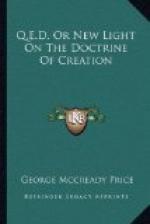Our next stopping place is in the Southern Appalachian Mountains of eastern Tennessee and northern Georgia. Here we have the Carboniferous strata dipping gently to the southeast, like an ordinary low monocline, under Cambrian or Lower Silurian, one of these so-called faults having a reported length of 375 miles,[44] while in another instance the upper strata are said to have been pushed about eleven miles in the direction of the “thrust."[45] These conditions, we are told, “have provoked the wonder of the most experienced geologists,"[46] because of the perfectly natural appearance of the surfaces of the strata affected; or as this same writer puts it, “The mechanical effort is great beyond comprehension, but the effect upon the rocks is inappreciable,” and “the fault dip is often parallel to the bedding of the one or the other series of strata."[47] Which means, in other words, that these “thrust planes” look just like ordinary planes of bedding between conformable strata.
[Footnote 44: Bailey Willis, Geol. Survey, Report, Vol. 13, p. 228.]
[Footnote 45: C.W. Hayes, Bull. Geol. Soc., Vol. 2, pp. 141-154.]
[Footnote 46: Willis, op. cit., p. 228.]
[Footnote 47: Willis, op. cit., p. 227.]
The Rocky Mountains furnish examples of many kinds of natural phenomena on the very largest scale, and those of the sort here under consideration are no exception to this rule. For here we have an immense area east of the main divide, extending from the middle of Montana up to the Yellowhead Pass in Alberta, or over 350 miles long, where the tops of the mountains consist of jointed limestones or argillites of Algonkian or pre-Cambrian “age,” resting on soft Cretaceous shales. Often the greater part of the mass of a range will consist of these “older” and harder rocks, which by the erosion of the soft underlying shales are left standing in picturesque, rectangular, cathedral-like masses, easily recognizable as far off as they can be seen. And the almost entire absence of trees or other vegetation helps one to trace out the relationship of these formations over immense areas with little or no difficulty.
In the latitude of the Bow River, near the Canadian Pacific main line, there is a long narrow valley of these Cretaceous beds some sixty-five miles long, called the Cascade Trough, with of course pre-Cambrian mountains on each side. Somewhat further south there are two of these Cretaceous valleys parallel to one another, and in some places three; while just south of the fiftieth parallel of latitude, at Gould’s Dome, there are actually five parallel ranges of these Palaeozoic mountains, with four Cretaceous valleys in between, one of these valleys, the Crow’s Nest Trough, being ninety-five miles long.




